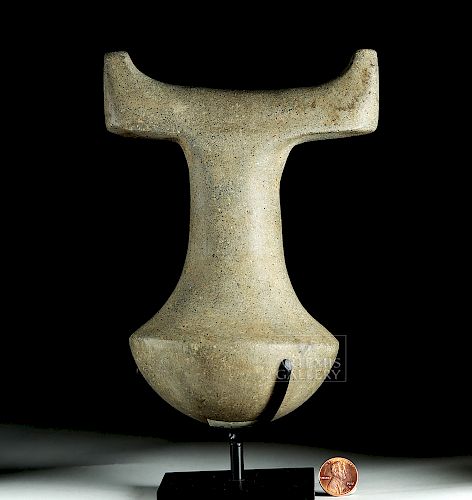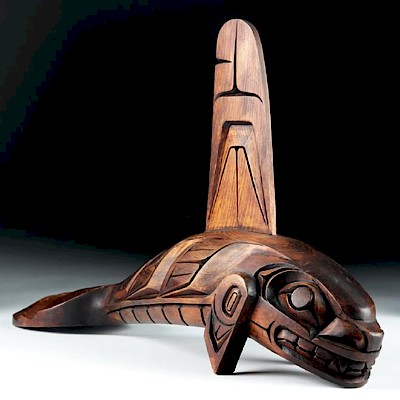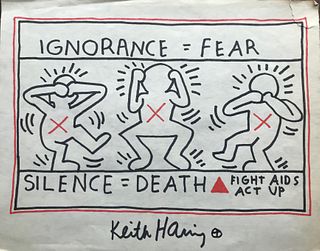17th to 19th C. Tahitian Basalt Poi Pounder
Lot 28b
About Seller
Artemis Fine Arts
686 S Taylor Ave, Ste 106
Louisville, CO 80027
United States
Selling antiquities, ancient and ethnographic art online since 1993, Artemis Gallery specializes in Classical Antiquities (Egyptian, Greek, Roman, Near Eastern), Asian, Pre-Columbian, African / Tribal / Oceanographic art. Our extensive inventory includes pottery, stone, metal, wood, glass and textil...Read more
Categories
Estimate:
$3,200 - $4,800
Absentee vs Live bid
Two ways to bid:
- Leave a max absentee bid and the platform will bid on your behalf up to your maximum bid during the live auction.
- Bid live during the auction and your bids will be submitted real-time to the auctioneer.
Bid Increments
| Price | Bid Increment |
|---|---|
| $0 | $25 |
| $300 | $50 |
| $1,000 | $100 |
| $2,000 | $250 |
| $5,000 | $500 |
| $10,000 | $1,000 |
| $20,000 | $2,500 |
| $50,000 | $5,000 |
| $100,000 | $10,000 |
| $200,000 | $20,000 |
About Auction
By Artemis Fine Arts
May 24, 2018
Set Reminder
2018-05-24 10:00:00
2018-05-24 10:00:00
America/New_York
Bidsquare
Bidsquare : Northwest Coast, Tribal, & Pre-Columbian Art
https://www.bidsquare.com/auctions/artemis-gallery/northwest-coast-tribal-pre-columbian-art-3238
Featuring Pacific Northwest Coast Native American Art from respected collector / dealer, Joseph Alphabet. Artemis Fine Arts info@artemisfinearts.com
Featuring Pacific Northwest Coast Native American Art from respected collector / dealer, Joseph Alphabet. Artemis Fine Arts info@artemisfinearts.com
- Lot Description
French Polynesia, Tahiti, Society Islands, ca. 17th to 19th century CE. A fabulous and hefty pounder, hand-carved from pale-grey basalt, meant to pulverize the roots of the taro plant into poi. The tool has a thick neck, a T-shaped handle with upturned terminals, and a hemispherical pounding face. The entire tool is incredibly smooth from repeated use, though some light roughness can be felt around the rim just above the pounding head. Finely-crafted and sturdy in composition, this is an exquisite example from French Polynesia! Custom museum-quality display stand included. Size: 5" W x 6.875" H (12.7 cm x 17.5 cm); 8.25" H (21 cm) on included custom stand.
Poi pounders, alongside adzes, were the most important stone tools in Polynesia (Europeans introduced steel weapons). They are used for pounding cooked taro root into poi, a staple of the islander diet. Taro root was steamed in an earthen oven, peeled using shells, and placed onto a slab of wood to be pounded. The pounded results were blended with water into a highly nutritious paste. Traditional calabash bowls were used as containers to hold poi mixtures, and traveling royalty were accompanied by their own poi maker, with his or her own poi-making implements like this one.
A similar example of a different color hammered for 25,000 Euro ($29,890) at Christie's, Paris (sale 1010, June 14, 2011, lot 90): https://www.christies.com/lotfinder/sculptures-statues-figures/pilon-iles-de-la-societe-5450759-details.aspx?from=searchresults&intObjectID=5450759&sid=c6a9684d-487f-4a8c-b546-2ee67ad1d962
Provenance: private Newport Beach, California, USA collection; ex-Jim Reed collection, Quincy, Illinois, USA
All items legal to buy/sell under U.S. Statute covering cultural patrimony Code 2600, CHAPTER 14, and are guaranteed to be as described or your money back.
A Certificate of Authenticity will accompany all winning bids.
We ship worldwide and handle all shipping in-house for your convenience.
#133629Surface wear commensurate with age and use, and some light discoloration, otherwise intact and choice. Light earthen deposits across most surfaces.Condition
- Shipping Info
-
All shipping is handled in-house for your convenience. Your invoice from Artemis Gallery will include shipping calculation instructions. If in doubt, please inquire BEFORE bidding for estimated shipping costs for individual items.
-
- Buyer's Premium



 EUR
EUR CAD
CAD AUD
AUD GBP
GBP MXN
MXN HKD
HKD CNY
CNY MYR
MYR SEK
SEK SGD
SGD CHF
CHF THB
THB















